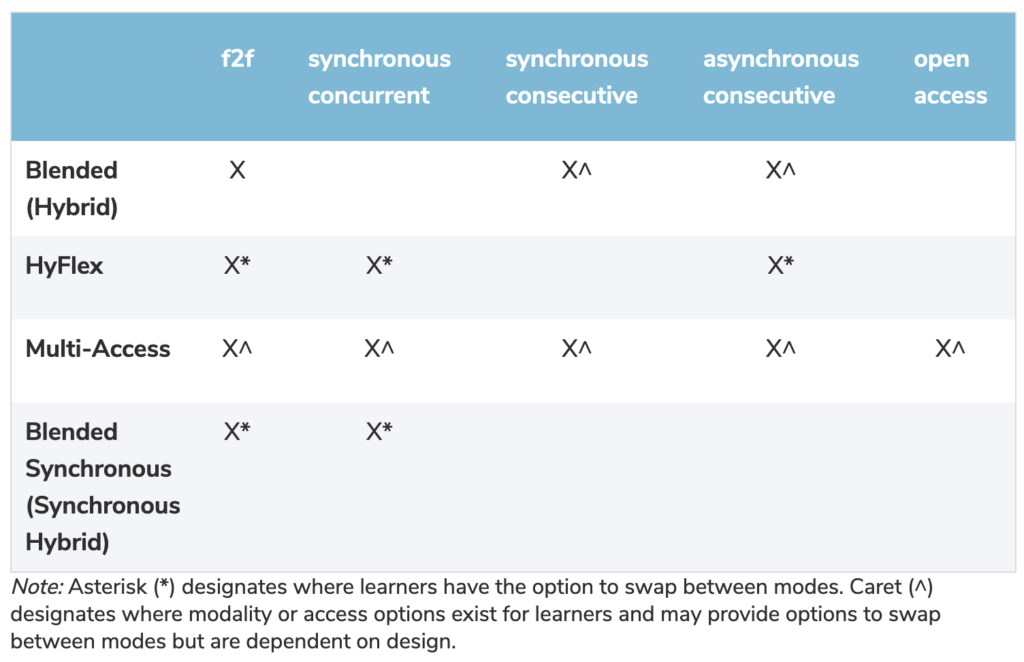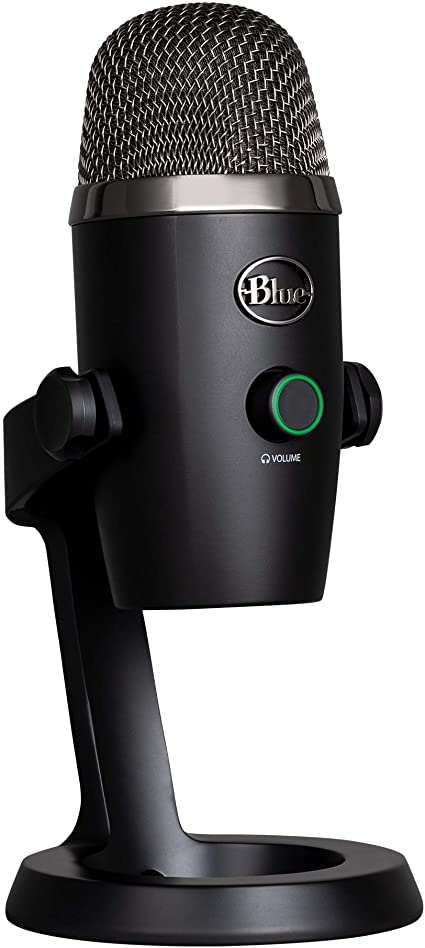In this Issue: Hybrid Teaching Tips
-
- Considerations for Concurrent Hybrid Teaching
- Nomenclature of Hybrid Teaching Models
- Increasingly Hybrid
- Hybrid Courses & Hybrid Programs
- Bridging the Distance Prize – Call for Submissions
- DEU support and contact information
Considerations for Concurrent Hybrid Teaching
Teaching in a concurrent hybrid (or, possibly more accurately, a concurrent hyflex) classroom is when you teach both in-person and remote students at the same time, usually by physically being present in the same classroom space as the in-person students. While this teaching modality has certainly been used more widely during the COVID-19 pandemic, it is also an interesting one to consider for a variety of situations in which students might require additional freedom and/or flexibility to choose either an in-person or remote learning experience. The possibilities of concurrent hybrid/hyflex teaching to increase the accessibility of courses and degree programs are the key part of why they are being considered more and more in higher education settings.
However, the challenges of concurrent hybrid teaching are real. For many instructors and students, this is an unfamiliar way of teaching and learning, and it is a unique approach that requires unique teaching solutions. While simply setting up a camera feed so that virtual students can “tune in” to the in-person event is a start, there is a lot more to consider with regards to the technical setup and, importantly, the instructional design of a high-quality concurrent hybrid course. The goal is to ensure that the remote students do not experience an inequity of teaching attention or a compromised quality of instruction. With that in mind, the following DEU blog post discusses some things to consider in taking hybrid teaching beyond simply livestreaming a lecture.
From the DEU Blog: Considerations for Concurrent Hybrid Teaching
If you are currently teaching a concurrent hybrid course, or planning for one in the future and looking for some help, contact deu.support@usask.ca. You can bounce some ideas off of one of our Instructional Designers, discuss some ways make your hybrid course more successful, or start to collaborate one-on-one with an ID and other DEU support staff to fully design, develop, and deliver your next hybrid course. The Distance Education Unit can help!
Nomenclature of Hybrid Teaching Models
Blended Learning combines traditional place-based f2f learning with online learning materials and often opportunities for online interactions with teachers and peers. Typically, the F2F interactions are reduced to make time for asynchronous online learning activities (readings, media, discussion forums, etc.). F2F interactions are often reserved for activities that make use of such things as case studies, problem-based learning scenarios, debates, discussions or demonstrations that provide a deepened understanding of the topics covered in the online, asynchronous, learning materials. In this model students are required to participate in both the F2F and Online activities. It may be possible for students to complete the course at a distance provided the F2F activities are streamed synchronously via a web conferencing platform and that the live instruction also actively engages students attending from a distance.
HyFlex design also combines F2F with online learning, but each class is offered in-person, synchronously online, and asynchronously online. In this model students have the autonomy to decide how to participate for each class. The key to success for The HyFlex design is that all students—regardless of how they choose to participate—must have equitable access to the learning materials, the instructor, and their peers. With this design students may choose to attend the class in person on Monday, but access the Wednesday class asynchronously and on Friday participate synchronously, but from home via the live stream.
Multi-Access design takes the HyFlex approach one step farther and adds the possibility of Open Access as a fourth access option which increases the inclusion to those beyond the registered students to “encourage the involvement of open learners and a reconsideration of locking resources behind a password-protected learning management system or copyrighting materials—not unlike the rationale supporting open-access research. – ” (Irvine, 2020). Multi-access design can encompass a wide range of merging modes of delivery whose configurations will depend on a variety of factors (policies, technologies, appropriate pedagogies).

Merging Modality Models – Irvine, 2020
See the DEU Blog post, Multi-Access Delivery Models for Uncertain Times, for a sample scenario of a Hyflex class, some considerations for equitable access, and links to more resources around Hybrid teaching models.
Increasingly Hybrid
If you are interested in finding out more about hybrid learning, this short 3-minute read may be of interest. Adam Stone’s article “Making Hybrid Learning Happen in Higher Ed” in EdTech: Focus on Higher Education provides a brief overview of some of the considerations for hybrid learning and supports needed for strategic planning and training. As well as forecasting the longevity of hybrid learning post-pandemic, Stone illustrates the need for close cooperation within institutions as a way to encourage effective hybrid learning.
Hybrid Courses & Hybrid Programs
A hybrid course is one that involves some combination of learning online and learning in the classroom. However, we can also use the term “hybrid” when discussing program design. So, a hybrid program is one that would involve time in the classroom and time learning online — and there are many different ways to apply this at the program level. A big part of the appeal of hybrid learning is in the academic flexibility it offers to working professionals and various types of “non-traditional” students, so there is a lot of potential to make whole programs (certificates and degrees) more accessible with hybrid program design.
For example, hybrid programs might look like any of the following:
-
- A largely online program with an intensive in-person workshop or “short course”.
- A largely online program with scheduled in-person orientation sessions, seminars, or capstone sessions.
- A mix of fully in-person courses with fully online courses.
- A program comprised of hyflex courses that let a learner decide day-to-day whether they will attend class in-person, or join the class online.
- A program that enrolls cohorts of fully in-person students and fully online students.
- A largely in-person program with certain self-paced learning requirements completed online, maximizing the impact of in-person learning time.
And more! DEU’s specialty is online learning, and we can help with the design, development, and delivery of anything from fully online to “a bit” online. For more assistance with hybrid instructional design, contact deu.support@usask.ca.
Bridging the Distance Prize – Call for Submissions
DEU would like to invite you to contribute to the DEU Digest through a contest and call for submissions. We’re looking to share your short articles and stories highlighting your winning moments with educational technology in online teaching and learning. This just-for-fun contest is open to all faculty, teaching staff as well as learning technology support staff across campus.
 As an incentive to participate and a reward for being awesome, DEU will select our favourite story at the end of the term and the winner will receive a Blue Yeti Nano USB condenser microphone! Two runner up prizes will also be awarded!
As an incentive to participate and a reward for being awesome, DEU will select our favourite story at the end of the term and the winner will receive a Blue Yeti Nano USB condenser microphone! Two runner up prizes will also be awarded!
Possible topics may include, but are not limited to:
-
- Awesome online learning activities
- Unique uses of a learning technology
- Connecting with students through technology
- Unique synchronous strategies/activities
- Asynchronous activities students loved
- Group work students didn’t hate
- Course designs that brought it all together
As an additional incentive to get your stories submitted today, the first two stories we receive will receive an early bird prize!
Contest Submissions can be made to deu.support@usask.ca.


